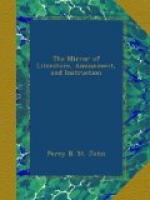[1] Fauna Boreali-Americana, or the Zoology of the Northern Parts of British America. Part II., containing the Birds. By W. Swainson, Esq, F.R.S. and John Richardson, Esq., M.D. F.R.S., &c. 4to. 253 pages, with 50 coloured plates, and 40 illustrative wood cuts. London, Murray, 1832.
Dr. Richardson, with zealous attachment to his pursuits, passed seven summers and five winters surrounded by the objects he has described with such fidelity. He is, therefore, not a mere book naturalist, but he has studied the habits and zoological details of the living animals; Mr. Swainson having assisted the Doctor in the systematic arrangement and production of the plates. Their descriptions include all the birds hitherto found over an immense expanse of country of the 49th parallel of latitude, and east of the Rocky Mountains, which lie much nearer to the Pacific Coast than to the eastern shore of America: many of these birds being, for the first time, made known to ornithologists. We have selected two of the most singular in their conformation: one from the Owls, which are numerous and beautiful; and the other from the Grouse, of which ten fine species are described.[2]
[2] Flocks of Ptarmigans, when pursued by the jar-falcon, endeavour to save themselves by plunging instantly into the loose snow, and making their way beneath it to a considerable distance.
* * * * *
THE ARCTIC, OR WHITE-HORNED OWL,
Strix (Bubo) Arctica, Swainson.
This very beautiful owl appears to be rare, only one specimen having been seen by the members of the Expedition. It was observed flying at mid-day in the immediate vicinity of Carlton House, and was brought down with an arrow by an Indian boy. Dr. Richardson could obtain no information respecting its habits.
From Mr. Swainson’s minute description we learn that the colour of the bill and claws is blueish black. The face is white, and a band of blackish-brown and white crosses the throat. The egrets or ear feathers are tipped with blackish-brown, the inner webs being white varied with wood-brown. The whole of the back is marked with undulated lines or fine bars of dark umber-brown, alternating with white: on the greater wing coverts the white is replaced by pale wood-brown. The primary and secondary feathers are wood-brown, margined inwards with white. They are crossed by umber-brown bars on both webs, the intervening spaces being finely speckled with the same. On the tertiary feathers, the wood-brown is mostly replaced by white. The tail-feathers are white, deeply tinged inwards by wood-brown, and crossed by bars of umber-brown; the tips are white. The chin is white. The throat is crossed by the band already mentioned, behind which there is a large space of pure snow white, that is bounded on the breast by blotches of liver-brown situated on the tips of




